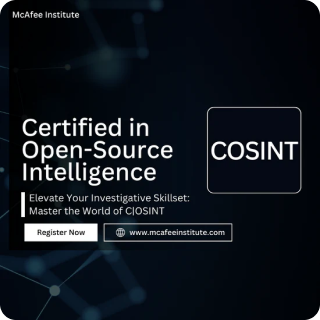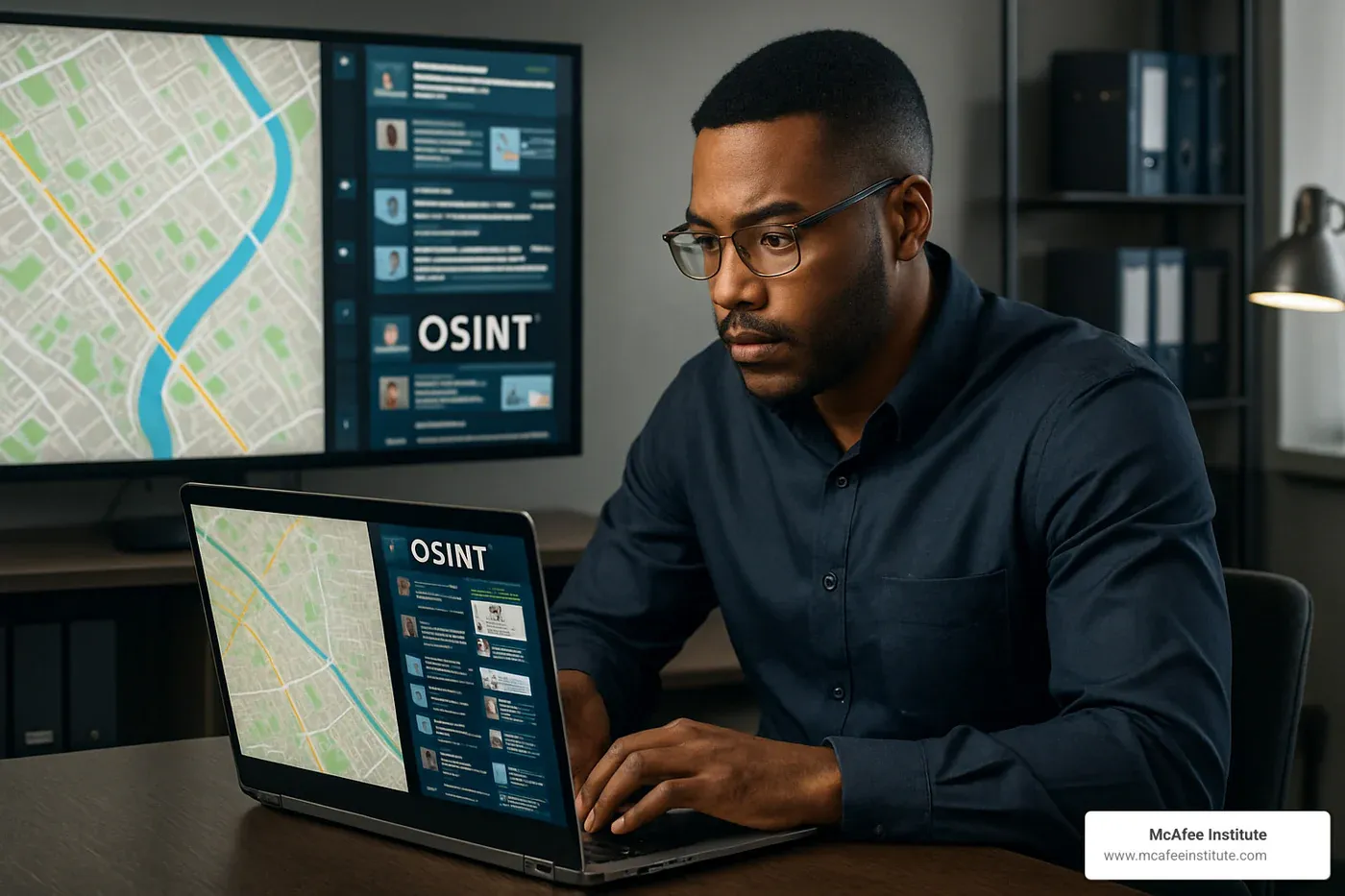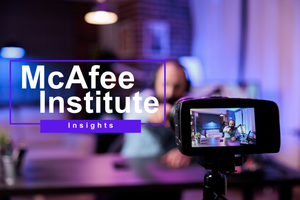Why Learning OSINT is Essential for Modern Investigators
To learn osint effectively, you need structured training, hands-on practice, and the right tools to gather intelligence from publicly available sources. Here's your quick-start roadmap:
Essential Steps to Learn OSINT:
- Master the fundamentals - Understand what OSINT is and the intelligence cycle
- Start with free resources - Join communities like /r/OSINT and Project Owl Discord
- Practice with real scenarios - Participate in Capture the Flag events and daily challenges
- Build your toolkit - Learn Google Dorks, reverse image search, and domain analysis
- Get certified - Validate your skills with recognized OSINT certifications
- Apply ethically - Always respect privacy laws and maintain proper operational security
Open Source Intelligence (OSINT) has evolved from military origins during World War II to become the backbone of modern investigations. Today's investigators - whether in law enforcement, cybersecurity, or private investigation - rely on OSINT to gather actionable intelligence from social media, public records, breach databases, and geospatial data.
The demand for OSINT skills has exploded. With over 78,000 members in the OSINT subreddit alone and specialized job boards like OSINT Jobs connecting practitioners worldwide, the field offers clear career advancement opportunities. Heath Adams has taught OSINT courses to over 170,000 students, proving the massive appetite for this specialized knowledge.
But here's the challenge: most investigators learn OSINT through trial and error. Without proper training, you risk legal violations, compromised investigations, or missed critical intelligence. The difference between amateur searching and professional OSINT lies in methodology, ethics, and systematic approach.
I'm Joshua McAfee, CEO and Founder of McAfee Institute, with over two decades of experience in law enforcement and intelligence operations spanning cybercrime and counterintelligence. Through our globally recognized certification programs, I've helped thousands of professionals learn osint techniques that advance their careers and improve their investigative capabilities. This guide will show you exactly how to build those same skills systematically and ethically.

Must-know learn osint terms:
What Is OSINT & Why It Matters
Picture this: A cybersecurity analyst finds unusual network activity at 3 AM. Instead of panicking, she opens her laptop and begins systematically gathering intelligence from publicly available sources. Within hours, she's identified the threat actor, mapped their previous campaigns, and built a comprehensive threat profile - all without accessing classified databases or breaking any laws.
This is Open Source Intelligence (OSINT) in action.
OSINT is the art and science of collecting, analyzing, and changing publicly available information into actionable intelligence. But here's the key difference between OSINT and regular internet searching: anyone can Google something, but not everyone can turn scattered data points into meaningful insights.
When you learn osint properly, you're not just learning to search better. You're developing a systematic approach to intelligence gathering that follows a proven methodology. Professional investigators use structured processes to plan their research, collect relevant data, analyze patterns, and present findings in ways that drive decisions.
The applications span virtually every field where information matters. Law enforcement officers use OSINT to track suspects and gather evidence for court cases. Military analysts assess threats and monitor global developments. Journalists verify sources and uncover investigative stories. Corporate security teams monitor their digital footprint and assess potential threats.
But here's what makes OSINT particularly fascinating: the same techniques that protect organizations are used by those who want to harm them. Cybercriminals conduct reconnaissance using identical methods, researching targets through social media, identifying vulnerabilities through job postings, and mapping organizational structures through public records. Understanding OSINT isn't just about gathering intelligence - it's about understanding how others might be gathering intelligence about you.
The compliance angle adds another layer of complexity. Organizations must balance their need for intelligence with privacy regulations, data protection laws, and ethical considerations. This creates demand for professionals who understand both the technical and legal aspects of intelligence gathering.

Core OSINT Sources
The digital world offers an overwhelming amount of information, but professional investigators know exactly where to look. Understanding these core source categories transforms random searching into systematic intelligence gathering.
Social media platforms represent the richest source of personal intelligence available today. Facebook posts reveal family relationships and travel patterns. LinkedIn profiles expose professional networks and career timelines. Instagram photos contain GPS coordinates and lifestyle indicators. Twitter conversations show political views and social connections. The key isn't just finding this information - it's knowing how to extract metadata, analyze posting patterns, and map relationships between accounts.
Public records provide the authoritative backbone of most investigations. Corporate filings reveal business relationships and financial status. Property records show ownership history and asset values. Court documents expose legal disputes and criminal history. Government databases contain licensing information and regulatory actions. These sources require patience and persistence, but they offer verified information that social media cannot provide.
Geospatial intelligence turns location data into investigative gold. Every photo taken with a smartphone potentially contains GPS coordinates. Satellite imagery services let you verify locations and track changes over time. Street view applications help confirm addresses and identify landmarks. Weather data can corroborate timelines and alibis. This geographic layer adds crucial context to other intelligence sources.
Metadata analysis reveals the hidden story behind digital files. Documents contain creation dates, author information, and software versions. Images expose camera models, editing history, and sometimes GPS coordinates. Videos show encoding details and processing timestamps. This technical layer often provides the most reliable evidence in investigations.
Breach data from compromised databases offers insights into password patterns, account relationships, and digital behavior. While this information must be handled with extreme care and legal compliance, it provides valuable intelligence about an individual's or organization's digital footprint and security practices.
Ethical & Legal Guardrails
Learning OSINT without understanding the ethical and legal boundaries is like learning to drive without knowing traffic laws - dangerous and potentially catastrophic for your career.
The GDPR revolution changed everything for investigators working with European data. Just because information appears publicly doesn't mean you can collect and process it freely. GDPR requires lawful basis for processing personal data, regardless of its public availability. This means understanding consent requirements, data minimization principles, and individual rights to erasure.
Privacy laws vary dramatically across jurisdictions, creating a complex web of compliance requirements. California's CCPA, Canada's PIPEDA, and dozens of other regional regulations each impose different restrictions on data collection and use. Professional investigators maintain current knowledge of applicable laws in their operating jurisdictions.
The concept of responsible disclosure becomes crucial when OSINT reveals security vulnerabilities or sensitive information. Finding a data breach or security flaw creates ethical obligations to report through proper channels rather than exploit or publicize the finding. This principle protects both the investigator and the affected organization.
Consent considerations create particularly complex scenarios in OSINT operations. While public information doesn't typically require explicit consent for collection, using that information for specific purposes may trigger consent requirements under various privacy frameworks. Understanding these nuances prevents legal complications down the road.
The distinction between data and intelligence isn't just academic - it's legally significant. Raw data becomes intelligence only after proper analysis, verification, and contextualization. Courts and regulatory bodies increasingly recognize this difference, making proper analytical frameworks essential for legal defensibility.
Professional investigators accept the "Be Ethical" principle: when in doubt, choose the more conservative approach. This mindset protects careers, maintains public trust, and ensures the long-term viability of OSINT as an investigative discipline.
More info about OSINT services and ethical frameworks can help you steer these complex requirements while maintaining investigative effectiveness.
How to Learn OSINT: Foundations & First Steps

To learn osint effectively, you must first understand the intelligence cycle - the systematic process that transforms raw information into actionable intelligence. This five-phase cycle provides the framework for every professional OSINT investigation:
Planning and Direction involves defining your intelligence requirements, identifying key questions, and establishing collection priorities. Without proper planning, you'll waste time on irrelevant data and miss critical intelligence.
Collection is where most beginners focus, but it's just one piece of the puzzle. Effective collection requires understanding which sources will yield the most relevant information for your specific intelligence requirements.
Processing and Integration transforms raw data into a format suitable for analysis. This includes organizing information, removing duplicates, and correlating data from multiple sources.
Analysis and Production applies analytical techniques to identify patterns, assess credibility, and develop conclusions. This phase separates professional investigators from amateur searchers.
Dissemination ensures your intelligence reaches the right audience in the appropriate format. A brilliant investigation is worthless if the results aren't communicated effectively.
Throughout this cycle, maintaining proper operational security (OPSEC) is critical. Your investigation activities can reveal your intentions, methods, and targets. Professional investigators use techniques like sock puppet accounts, VPNs, and compartmentalized research to protect their operations.
Note-taking becomes crucial when handling large amounts of information. Effective OSINT practitioners develop systematic approaches to documenting sources, tracking leads, and maintaining chain of custody for digital evidence.
Learn OSINT Through Free Resources
The OSINT community is remarkably generous with knowledge sharing. Here are the top free resources to start your learning journey:
YouTube Channels offer visual learning for complex techniques. The 5-hour introductory OSINT course mentioned in our research provides comprehensive coverage of fundamental concepts. OSINT Dojo creates structured learning paths specifically designed for beginners.
Reddit Communities like /r/OSINT provide peer support and real-world examples. With over 78,000 members, this community offers daily discussions, tool recommendations, and case studies from practicing investigators.
Newsletters keep you current with evolving techniques. Sector035's "Week in OSINT" and Lorand Bodo's weekly updates provide curated intelligence on new tools, techniques, and trends.
Discord Communities offer real-time collaboration and mentorship. Project Owl Discord hosts over 32,000 members and provides specialized channels for different OSINT disciplines. The Kase Scenarios Discord focuses on interactive learning through realistic case studies.
Capture the Flag Events provide hands-on practice with real scenarios. Trace Labs crowdsources OSINT skills to assist law enforcement with missing persons investigations. Quiztime offers daily Twitter challenges that sharpen rapid analysis skills.
Top Free Starter Courses:
- 5-hour YouTube OSINT fundamentals course
- OSINT Dojo structured learning modules
- Basel Institute OSINT course with practical case studies
- Exposing the Invisible toolkit for journalists and researchers
- SANS Institute introductory articles and webcasts
Accelerate Your OSINT Learning with McAfee Institute
While free resources provide excellent foundations, structured professional training accelerates your progress and ensures comprehensive coverage of advanced techniques. At McAfee Institute, we've designed our OSINT programs specifically for working professionals who need practical skills they can apply immediately.
Our certification programs are recognized by government agencies and employers worldwide. Unlike generic online courses, our curriculum is developed by active practitioners with decades of field experience. We understand the difference between academic theory and operational reality.

Certified in Open Source Intelligence (C|OSINT)
Advance Your Career with Industry-Leading OSINT Training and a Globally Recognized Credential.
The flexibility of our online learning platform accommodates busy schedules. You can progress at your own pace while maintaining access to instructor support and peer collaboration through our exclusive community platforms.
We offer multiple certification tracks to match your career goals and current skill level. Whether you're starting from scratch or looking to formalize existing knowledge, our programs provide clear progression pathways.
Our courses qualify for Continuing Education Units (CEUs), helping you maintain professional certifications and demonstrate ongoing professional development to employers.
We stand behind our training with comprehensive refund policies, ensuring you can invest in your education with confidence.
Training Tracks: Top OSINT Courses to Consider provides detailed comparisons of our various programs and can help you select the right path for your career goals.
Essential Tools & Techniques for Investigations

When you learn osint, you quickly find that basic Google searches only scratch the surface. Professional investigators rely on specialized tools and techniques that can uncover intelligence hidden from casual searches.
The difference between amateur and professional OSINT often comes down to knowing the right tools for each situation. While expensive commercial platforms grab attention, many of the most powerful techniques use free tools combined with advanced search operators and systematic methodology.
Google Dorks form the backbone of advanced search techniques. These specialized operators help you find exposed databases, specific file types, and hidden information that normal searches miss. The site: operator lets you search within specific domains, while filetype: reveals documents that organizations never intended to make public. Using inurl: and intitle: operators helps you locate administrative panels, configuration files, and other sensitive materials.
Social media intelligence requires more than scrolling through profiles. Professional investigators know how to extract metadata from posts, analyze posting patterns, and map relationships between accounts across multiple platforms. They understand which platforms leak the most information and how to correlate activities across different social networks.
Domain analysis reveals the digital infrastructure behind websites and email addresses. WHOIS databases provide ownership information, registration history, and associated IP addresses. When combined with DNS analysis and historical data, these tools paint comprehensive pictures of digital assets and their connections.
Image analysis has become crucial in our visual world. Every photo contains hidden metadata that can reveal GPS coordinates, camera models, and creation timestamps. Reverse image searches help verify authenticity and trace images across the internet. Professional investigators also know how to detect image manipulation and identify deepfakes.
Link analysis platforms help visualize complex relationships between people, organizations, and digital assets. When investigations involve multiple entities and connections, these tools transform overwhelming data into clear, actionable intelligence.
Automation scripts can process large datasets and monitor sources for changes. However, successful investigators balance automation with human analysis. Scripts handle repetitive tasks, but human insight catches context and nuance that automated tools miss.
Building Your OSINT Lab
Setting up a proper OSINT lab isn't just about having cool tools - it's about creating a controlled environment that protects your investigations and maintains legal compliance.
Virtualization provides the foundation for serious OSINT work. Virtual machines isolate different investigations and create clean environments for specific tools. If something goes wrong during an investigation, you can simply restore a clean snapshot without compromising other cases.
Most investigators start with VMware Workstation or VirtualBox. Both platforms let you run multiple operating systems simultaneously and create specialized environments for different investigation types. You might have one VM configured for social media research, another for malware analysis, and a third for general web investigations.
VPN services protect your identity and location during sensitive investigations. However, not all VPNs work well for OSINT. You need services that don't log your activity and provide reliable connections across multiple countries. Some investigations require appearing to browse from specific geographic locations.
Tor browser enables anonymous browsing when investigations involve sensitive topics or potentially dangerous subjects. Understanding Tor's capabilities and limitations keeps you safe while gathering intelligence. Tor protects your identity but doesn't make you invisible to advanced adversaries.
Specialized browsers configured for different investigation types help maintain separation between cases. Some investigators maintain separate browser profiles with different sock puppet identities. Each profile has its own bookmarks, extensions, and browsing history.
Note-taking applications must handle massive amounts of information while keeping everything searchable and organized. Traditional note apps quickly become overwhelming during complex investigations. Specialized tools like Hunchly automatically capture and organize your research as you browse.
Your virtual machine requirements depend on investigation complexity. Start with at least 8GB of RAM and 30GB of storage per VM, but expect to need more as your skills develop. Serious practitioners often run multiple VMs simultaneously, requiring powerful hardware.
The choice between free and commercial tools often comes down to your specific needs and budget. Free options like Google and DuckDuckGo provide excellent starting points for search, while commercial platforms like Maltego offer advanced visualization capabilities. At McAfee Institute, we focus on teaching techniques that work regardless of your tool budget, then show you how professional-grade platforms can accelerate your investigations.
Step-By-Step Mini Investigation
Let's walk through a real investigation to show how these tools work together. This scenario demonstrates the systematic approach that separates professional investigators from casual searchers.
The Scenario: You receive a suspicious email with an attached image claiming to show a security incident at your organization. The sender demands immediate action and payment. You need to verify authenticity and trace the source.
Step 1: Reverse Image Search starts your investigation. Upload the image to Google Images and TinEye to see if it appears elsewhere online. Often, scammers repurpose images from news articles or stock photo sites. If the image shows up in unrelated contexts, you've caught your first red flag.
Step 2: Metadata Analysis reveals hidden information within the image file. Extract EXIF data using tools like metadata2go to check for GPS coordinates, camera information, and creation timestamps. Scammers often forget to strip this data, leaving digital fingerprints that contradict their claims.
Step 3: Domain Analysis investigates the sender's email infrastructure. Run WHOIS lookups on the sender's domain to check registration dates, registrant information, and hosting providers. Recently registered domains or privacy-protected registrations raise immediate suspicions.
Step 4: Username Pivot expands your investigation across platforms. Search for the sender's username on social media, forums, and other online services. Look for posting patterns, associated accounts, and profile information that might reveal the sender's true identity or motives.
Step 5: Breach Data Check provides historical context about the email address. Query databases like HaveIBeenPwned to see if the address appears in known data breaches. This information helps assess whether the account might be compromised or if it's part of a larger scam operation.
Step 6: Report Writing documents your findings systematically. Professional reports include executive summaries for decision-makers, detailed findings with confidence levels, and specific recommendations for action. Your report should be clear enough that someone else could verify your work.

This systematic approach demonstrates why professional OSINT training matters. Each step builds on the previous one, creating a comprehensive picture that single-source investigations miss. When you learn osint through structured programs, you develop the methodical thinking that turns scattered information into actionable intelligence.
Practice, Community & Staying Current
The OSINT world moves fast. New tools pop up weekly, techniques evolve constantly, and data sources change without warning. If you want to learn osint effectively and stay relevant, you need to be plugged into the community and practicing regularly.
Think of it like learning a musical instrument - you can't just read about it and expect to play Carnegie Hall. OSINT requires the same kind of regular practice and community engagement to develop real expertise.
Capture the Flag (CTF) Events offer some of the best hands-on learning opportunities available. Trace Labs runs Search Party CTFs that are particularly meaningful because you're using your developing skills to help locate actual missing persons. These events combine skill building with genuine social impact, making the learning process feel purposeful rather than academic.
The beauty of CTFs is that they simulate real-world pressure and time constraints. You'll quickly find which techniques you've truly mastered and which ones still need work when you're racing against the clock.
Daily practice platforms keep your skills sharp between major events. Quiztime on Twitter throws out quick challenges that you can tackle during coffee breaks. Sourcing.Games provides interactive puzzles that were originally designed for recruiters but work perfectly for any OSINT practitioner looking to stay nimble.
These bite-sized challenges are perfect for busy professionals who can't dedicate hours to practice but want to maintain their edge.
Start.me dashboards become essential as your toolkit grows. Many experienced practitioners share their curated dashboards publicly, giving you excellent starting points for organizing your own resources. Building and maintaining your dashboard forces you to stay organized and helps you find gaps in your toolkit.
The process of organizing your resources also helps reinforce your learning and makes you more efficient during actual investigations.
Newsletter subscriptions keep you informed without overwhelming your inbox. Sector035's weekly roundup is practically required reading in the OSINT community. Jake Creps' newsletter and other specialized feeds from leading practitioners ensure you don't miss important developments.
The key is finding the right balance - enough information to stay current without drowning in content that distracts from actual practice.
Social media monitoring using keywords like "OSINT," "SOCMINT," and "OPSEC" helps you catch new techniques as they're developed and shared. The OSINT community is remarkably generous about sharing findies, but you need to be actively watching to benefit from this knowledge sharing.
Continuous learning requires balancing breadth with depth. The most effective practitioners develop strong specializations while maintaining solid foundational knowledge across all areas. You might become the go-to expert for geospatial intelligence while still being competent in social media analysis and breach data research.

Certifications & Proof of Skill
Let's be honest - anyone can claim they know OSINT. Professional certifications separate the serious practitioners from the weekend hobbyists. They provide credible proof of your competency that employers and clients can trust.
C|OSINT (Certified Open Source Intelligence) stands as one of the most recognized credentials in the field. This certification demonstrates comprehensive knowledge of OSINT methodologies, tools, and ethical practices. It's not easy to earn, which is exactly why it carries weight with employers.
McAfee Institute certifications are specifically designed for working professionals who need practical skills they can apply immediately. Unlike academic programs that focus on theory, our certifications are recognized by government agencies worldwide and combine deep knowledge with hands-on application.
Our graduates don't just pass exams - they can walk into real investigations and perform effectively from day one.
Micro-credentials and digital badges provide recognition for specific skill areas without requiring comprehensive certification programs. These can be valuable stepping stones, especially if you're developing expertise in specialized areas like social media intelligence or geospatial analysis.
Recruiter visibility increases dramatically when you have recognized certifications. Many employers now specifically search for certified OSINT professionals when filling investigative and intelligence roles. Without proper credentials, your resume might never make it past the initial screening.
The investment in certification pays dividends throughout your career. OSINT Certification Costs: Worth the Investment? breaks down the return on investment for various certification programs and helps you make informed decisions about your professional development.
Landing an OSINT Job
The OSINT job market offers incredible opportunities across government, private sector, and consulting roles. But success requires more than just technical skills - you need to demonstrate practical application and professional credibility.
Resume optimization for OSINT positions should emphasize specific tools, methodologies, and case outcomes rather than generic "research skills." Instead of saying you're "good at research," specify that you've used Maltego for link analysis or conducted social media investigations using advanced search operators. Quantify your achievements wherever possible and highlight certifications or specialized training prominently.
Portfolio development showcases your capabilities through sanitized case studies and tool demonstrations. Create GitHub repositories containing OSINT scripts or methodologies that demonstrate your technical competency. Document your investigation processes and share anonymized examples of your analytical work.
Employers want to see how you think and approach problems, not just what tools you can use.
OSINT Jobs site statistics show growing demand across multiple sectors, with the ability to filter by country, experience level, and specialization area. This helps you target your job search effectively and understand market demands in your geographic area.
Interview preparation should include hands-on demonstrations of your capabilities. Many employers conduct practical assessments during the interview process, so maintaining sharp skills is crucial. Be prepared to walk through your investigation methodology and explain your decision-making process.
Networking within the OSINT community opens doors to opportunities that never reach public job boards. Active participation in Discord communities, CTF events, and professional associations builds valuable relationships. The OSINT community is tight-knit, and personal recommendations carry significant weight.
Mentorship relationships provide guidance on career progression and skill development. Many experienced practitioners are willing to mentor newcomers who demonstrate genuine commitment to ethical practice and continuous learning. Don't be afraid to reach out - most professionals remember when they were starting out and appreciate the opportunity to give back.
Frequently Asked Questions about Learning OSINT
What hardware/software do I need to start?
Here's the good news: you don't need to break the bank to learn osint effectively. I've seen investigators produce excellent results using basic equipment that most people already own.
A standard laptop or desktop with 8GB RAM and 30GB free storage will handle most beginner investigations without any issues. Your biggest investment should be time and curiosity, not expensive gadgets.
For software, start with the essentials. Firefox or Chrome work perfectly for most investigations. Add a reliable VPN service to protect your privacy during research. A simple note-taking app like Obsidian or even basic text files will keep your findings organized. You'll also want basic image editing software for metadata analysis.
If you're planning to dive deeper into advanced techniques, consider virtual machine software like VirtualBox. This lets you create isolated environments for different investigations - a practice that becomes crucial as you handle more sensitive cases.
As your skills grow, you might want to upgrade to a second monitor for keeping notes visible while investigating, external storage for preserving case files, and even a webcam cover for operational security during sensitive work.
Many successful OSINT professionals started with whatever computer they had available. The tools don't make the investigator - your methodology and ethical approach do.
How do I practice legally without getting in trouble?
This question keeps many beginners awake at night, and rightfully so. The key is starting safe and building your confidence gradually.
Practice on yourself first. Seriously - investigate your own digital footprint. Search for your name, email addresses, and usernames across various platforms. You'll be amazed at what you find, and you'll gain hands-on experience without any privacy concerns.
Designated practice platforms provide safe environments for skill development. CTF events like Trace Labs offer legal frameworks for practicing on real missing persons cases. These platforms have proper permissions and legal protections built in.
When exploring on your own, stick to genuinely public information. Focus on social media posts with public privacy settings, published news articles, and official government records. If someone had to log in to see it, consider it off-limits for practice.
Understanding privacy laws isn't optional - it's fundamental. GDPR in Europe and various state laws in the US have specific requirements for handling personal data, even when it's publicly available. Spend time learning these regulations for your jurisdiction.
Always document your methods carefully. Keep detailed records of your information sources and collection techniques. This demonstrates due diligence and helps you identify potential legal issues before they become problems.
Most importantly, avoid active engagement with targets. Don't interact with people or attempt to elicit information through deception. Stick to passive collection methods that don't involve direct contact. Think of yourself as a digital archaeologist, not an undercover agent.
Which certification should I choose first?
Choosing your first OSINT certification feels overwhelming with so many options available. The right choice depends on where you are now and where you want to go professionally.
Complete beginners should start with foundational courses covering OSINT basics, ethics, and core methodologies. McAfee Institute's introductory programs provide comprehensive coverage without assuming you already know the jargon or have prior investigative experience.
Law enforcement and government professionals need certifications recognized by their agencies. Many departments require specific credentials for advancement or specialized assignments. Check with your training coordinator about approved programs before making your investment.
Private sector and corporate security roles emphasize different skills. Look for certifications focusing on competitive intelligence, threat assessment, and risk management. These programs often include business applications that directly translate to corporate environments.
Career changers benefit from comprehensive programs providing both theoretical knowledge and practical skills. Seek certifications that include portfolio development and job placement assistance - you'll need both the knowledge and the proof of competency.
Budget considerations extend beyond the initial certification cost. Factor in study materials, practice tools, and continuing education requirements. Some certifications require annual renewal or continuing education credits that add up over time.
The most important factor is choosing a program that provides practical skills you can apply immediately. Whether you're strengthening your current role or preparing for a career transition, your certification should bridge the gap between where you are and where you want to be.
Open Source Intelligence Certification in Modern Investigations offers detailed guidance on selecting the right certification for your specific situation and career goals.
Conclusion
Your journey to learn osint doesn't end with reading this guide - it's just the beginning of an exciting career path that combines detective work with cutting-edge technology. The field offers incredible opportunities for those who approach it with dedication, curiosity, and a strong ethical foundation.
Think of OSINT mastery like learning a musical instrument. You can't become proficient by reading about it or watching videos alone. You need consistent practice, proper instruction, and feedback from experienced practitioners. The same principle applies whether you're investigating missing persons, tracking cyber threats, or conducting competitive intelligence.
Career growth in OSINT follows a predictable pattern. Entry-level positions focus on data collection and basic analysis. Mid-level roles involve complex investigations and tool development. Senior practitioners lead teams, develop methodologies, and shape organizational intelligence strategies. Each level requires deeper technical skills and broader analytical thinking.
The most successful investigators I've worked with share common habits. They practice regularly with new scenarios, even when work doesn't require it. They maintain curiosity about emerging tools and techniques. Most importantly, they never compromise their ethical standards, even when facing pressure to cut corners.
Joining professional communities transforms your learning experience from solitary study to collaborative growth. The Discord servers, Reddit communities, and certification programs create networks that last throughout your career. I've seen countless investigators land their dream jobs through connections made in these communities.
Your ethical mindset will define your reputation and career trajectory more than any technical skill. The OSINT community is surprisingly small, and word travels fast about practitioners who violate privacy or operate outside legal boundaries. Conversely, investigators known for ethical practice and reliable results find opportunities constantly coming their way.
At McAfee Institute, we've watched thousands of professionals transform their careers through proper OSINT training. Our students work in federal agencies across the United States, corporate security teams in Germany, law enforcement in Canada, and private investigation firms in Australia. What they all share is the decision to invest in structured, comprehensive training rather than trying to piece together knowledge from random sources.
The difference between amateur searching and professional investigation lies in methodology, ethics, and systematic approach. Our globally recognized programs provide exactly these foundations, backed by instructors with decades of real-world experience. We don't just teach tools - we develop investigative thinking that adapts as technology evolves.
Whether you're a police officer looking to improve your investigative capabilities, a security professional defending against threats, or someone completely new to the field, the path forward is clear. Start with solid foundations, practice consistently, engage with the community, and maintain unwavering ethical standards.
The world faces increasingly complex security challenges that require skilled OSINT practitioners to solve. From tracking disinformation campaigns to locating missing persons, from preventing cyber attacks to supporting national security operations, the need for ethical, competent investigators continues growing.
Your curiosity brought you to this guide. Now it's time to transform that curiosity into investigative mastery through proper training and dedicated practice. The investment you make in learning OSINT today will pay dividends throughout your career, opening doors you might never have imagined.
Ready to take the next step? Open Source Intelligence Certification in Modern Investigations shows you exactly how our programs can accelerate your journey from curious beginner to confident professional investigator.











Member discussion